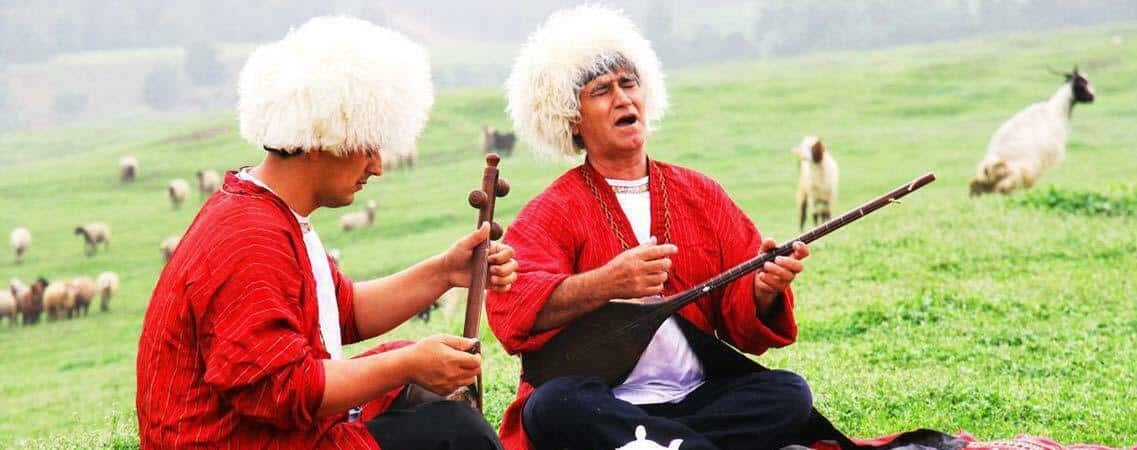The People of Iran: Ethnicities and Cultures

People of Persian descent make up roughly 50 percent of Iran’s population, yet many other ethnic groups, including Azaris, Armenians, Assyrians, and Jews, have settled on the land.
People of Persian descent make up roughly 50 percent of Iran’s population, yet many other ethnic groups, including Azaris, Armenians, Assyrians, and Jews, have settled on the land. Historically, many groups have had little contact with one another because large distances separated them. This has meant that the groups have been able to retain their languages and customs for hundreds, or even thousands, of years.
Persians are descendants of the first Aryan settlers. They live mostly in the central desert plateau and in Iran’s northern provinces. They speak Persian, which they call Farsi, and most are Shia Muslims. Their traditional dress varies by region, but men usually wear wide, loose pants, a long tunic, and a cap or large turban. Women’s traditional dress includes wide, loose pants, a dress, a veil, and often a shawl.
Today, Persian men usually wear western-style clothing, as do women beneath their rouposh or chador.
Contents
Turkmens

Two percent of Iran’s population belongs to a Turkic people known as Turkmen. Most Turkmen live in the north and northeast, near the Republic of Turkmenistan, and speak a language that is also called Turkmen.
The majority live in cities, yet rural Turkmen tribes still flourish in Iran. Many rural Turks are known for their great horseback riding skills. They ride Turkmen horses, which are famous for their endurance.
Kurds

There are approximately six million Kurds in Iran, making up seven percent of the population. Kurds live along the western border, in the Zagros Mountains, and share a common culture with the Kurds in neighboring Turkey and Iraq.
A traditionally nomadic people, some Kurds still live in the countryside where they work as farmers. Most have settled in cities, which have become crowded with refugees from neighboring countries. Iranian Kurds speak Kurdish as well as Persian.
The majority are Sunni Muslims, but many also practice Sufism, a mystical form of Islam.
- Uraman, a magnificent stair-stepped village in the beautiful Kurdistan
- Pir Shalyar, an Ancient Ceremony Still Alive In the Mountains of Kurdistan
Turkic
Turkic peoples make up 25 percent of Iran’s population. They are descended from Turkic tribes who migrated from central Asia in the 1000s. About 90 percent of Iran’s Turkic peoples are Azaris.

They speak a Turkic dialect called Azari, and almost all are Twelver Shi’i Muslims. Some Azaris live in small villages in the Azerbaijan region, in the Zagros Mountains of northwestern Iran. There, they work as farmers, herders, and traders. Others live in cities, where they own stores and other businesses.
Since Pahlavi rule, Azaris have not been allowed to learn their language in school, though today there are Azari newspapers and radio programs. Some of Iran’s Azaris are striving for language rights and for autonomy, or the right to run their local government affairs.
Arabs

Arabs make up three percent of Iran’s population. The majority are Shia Muslims, and they speak a dialect of Arabic, in addition to Persian. Most live in the southwestern province of Khuzestan, but Arabs also live on the Persian Gulf islands and along the southern coast.
Arabs who live along the coast are known as Bandaris, from the Persian word for “port.” Traditional Bandari dress for women consists of loose pants with layers of embroidered or printed loose wraps over top.
Traditional Bandari dress for men is a long, sleeveless, white robe called an abba, sandals, and sometimes a turban. In other areas of Iran, Arab men wear floor-length shirt-dresses called thobes or dishdashas, and loose headscarfs called gutras.
The Baluchis

Balochistan is a region divided between Iran and Pakistan. The climate there is very hotand dry, and rain comes in heavy storms that cause floods and erosion.
The Baluchis are traditionally nomadic, but are beginning to settle in villages. There, they raise camels, sheep, and goats. In oasis areas, they grow crops, such as oranges, pomegranates, and bananas. Baluchis are also expert carpetmakers and embroiderers. Their weavings and textiles are known for being long lasting.
According to the 2011 Iranian census, 99.38% of Iranians believe in Islam, while 0.2% of the population believe in officially recognized minority religions, Christianity, Judaism and Zoroastrianism.
Muslims believe in one God. “God” in Arabic, the language of the Qur’an, is Allah. Muslims also follow the teachings of God’s prophets, the last of whom was Muhammad. After Prophet Muhammad’s death in 632 A.D., two main branches of Islam developed: Shi’i and Sunni. The Shi’is believed that the leadership of Islam was passed down to Muhammad’s descendants through his cousin and son-inlaw, Ali. The Sunnis believed that the true leaders were those elected from among Muhammad’s closest followers.
Over the centuries, other differences in beliefs and Sunna, or codes of behavior, developed between Shi’is and Sunnis. A branch of Shi’i Islam, called Jafari, or Twelver, Shi’i Islam is based on the belief that Prophet Muhammad’s twelfth and final descendant, who disappeared in the 800s, never died. Twelver Shia believe that he has been in hiding, and will return one day to lead the people.
Read More